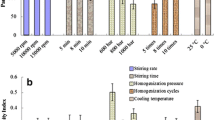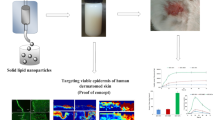Abstract
The objective of this study is to enhance skin permeation of finasteride and dutasteride for the treatment of androgenetic alopecia using surface-modified liquid crystalline nanoparticle (sm-LCN) dispersion. LCN entrapped with the drugs was prepared by using monoolein as a liquid crystal former, and surface modification was performed by treatment of the LCN dispersion with same volume of 1 % v/v acetic acid solution containing chitosan. Physicochemical properties of the LCN’s were studied with regard to particle size, polydispersity index, zeta potential, and release of the drugs. Skin permeation of drugs entrapped into the LCN and sm-LCN was investigated with porcine abdominal skin using Franz diffusion cell. Cytotoxicity of the LCN’s was also studied using human skin keratinocytes. The particle size and zeta potential of the LCN were 197.9 ± 2.5 nm and −20.2 ± 1.9 mV, respectively, and sm-LCN showed slightly bigger size and positive zeta potential due to the presence of thin coating on the surface of the nanoparticles. Compared to LCN, sm-LCN resulted in significantly enhanced skin permeation of the drugs whereas in vitro release was significantly reduced. Cell viability as a measure of cytotoxicity was above 80 % up to 20 μg/ml concentration of both LCN and sm-LCN. In conclusion, sm-LCN may provide a strategy to maximize therapeutic efficacy minimizing unwanted systemic side effects associated with the use of the drugs for the treatment of androgenetic alopecia.





Similar content being viewed by others
References
Azzouni, F., N. Zeitouni, and J. Mohler. 2013. Role of 5α-reductase inhibitors in androgen-stimulated skin disorders. Journal of Drugs in Dermatology 12: e30–e35.
Banka, N., M. Bunagan, and J. Shapiro. 2013. Pattern hair loss in men: diagnosis and medical treatment. Dermatologic Clinics 31: 129–140.
Blumeyer, A., A. Tosti, A. Messenger, P. Reygagne, V. del Marmol, P.I. Spuls, M. Trakatelli, A. Finner, F. Kiesewetter, R. Trüeb, R. Rzany, and U. Blume-Peytavi. 2011. Evidence-based (S3) guideline for the treatment of androgenetic alopecia in women and in men. Journal der Deutschen Dermatologischen Gesellschaft 9: S1–S57.
Boyapati, A., and R. Sinclair. 2013. Combination therapy with finasteride and low-dose dutasteride in the treatment of androgenetic alopecia. Australasian Journal of Dermatology 54: 49–51.
Cevc, G., and U. Vierl. 2010. Nanotechnology and the transdermal route: a state of the art review and critical appraisal. Journal of Controlled Release 141: 277–299.
Chang, D.P., M. Jankunec, J. Barauskas, F. Tiberg, and T. Nylander. 2012. Adsorption of lipid liquid crystalline nanoparticles on cationic, hydrophilic, and hydrophobic surfaces. ACS Applied Materials and Interfaces 4: 2643–2651.
Farshi, S., P. Mansouri, and F. Rafie. 2012. A randomized double blind, vehicle controlled bilateral comparison study of the efficacy and safety of finasteride 0.5% solution in combination with intense pulsed light in the treatment of facial hirsutism. Journal of Cosmetic and Laser Therapy 87: 193–199.
Guo, C., J. Wang, F. Cao, R.J. Lee, and G. Zhai. 2010. Lyotropic liquid crystal systems in drug delivery. Drug Discovery Today 15: 1032–1040.
Gupta, A.K., and A. Charrette. 2014. The efficacy and safety of 5α-reductase inhibitors in androgenetic alopecia: a network meta-analysis and benefit-risk assessment of finasteride and dutasteride. Journal of Dermatological Treatment 25: 156–161.
Gur, S., P.J. Kadowitz, and W.J. Hellstrom. 2013. Effects of 5-alpha reductase inhibitors on erectile function, sexual desire and ejaculation. Expert Opinion on Drug Safety 12: 81–90.
Hajheydari, Z., J. Akbari, M. Saeedi, and L. Shokoohi. 2009. Comparing the therapeutic effects of finasteride gel and tablet in treatment of the androgenetic alopecia. Indian Journal of Dermatology, Venereology and Leprology 75: 47–51.
Inui, S., and S. Itami. 2011. Molecular basis of androgenetic alopecia: From androgen to paracrine mediators through dermal papilla. Journal of Dermatological Science 61: 1–6.
Inui, S., and S. Itami. 2013. Androgen actions on the human hair follicle: perspectives. Experimental Dermatology 22: 168–171.
Jepps, O.G., Y. Dancik, Y.G. Anissimov, and M.S. Roberts. 2013. Modeling the human skin barrier: Towards a better understanding of dermal absorption. Advanced Drug Delivery Reviews 65: 152–168.
Kulkarni, C.V., W. Wachter, G. Iglesias-Salto, W. Engelskirchen, and S. Ahualli. 2011. Monoolein: a magic lipid? Physical Chemistry Chemical Physics: PCCP 13: 3004–3021.
Lapteva, M., and Y.N. Kalia. 2013. Microstructured bicontinuous phase formulations: their characterization and application in dermal and transdermal drug delivery. Expert opinion on drug delivery 10: 1043–1059.
Liu, H., S. Chen, Y. Zhou, X. Che, Z. Bao, S. Li, and J. Xu. 2013. The effect of surface charge of glycerol monooleate-based nanoparticles on the round window membrane permeability and cochlear distribution. Journal of Drug Targeting 21: 846–854.
Madheswaran, T., R. Baskaran, R.K. Thapa, J.Y. Rhyu, H.Y. Choi, J.O. Kim, C.S. Yong, and B.K. Yoo. 2013a. Design and in vitro evaluation of finasteride-loaded liquid crystalline nanoparticles for topical delivery. AAPS PharmSciTech 14: 45–52.
Madheswaran, T., R. Baskaran, C.S. Yong, and B.K. Yoo. 2013b. Enhanced topical delivery of finasteride using glyceryl monooleate-based liquid crystalline nanoparticles stabilized by cremophor surfactants. AAPS PharmSciTech 15: 44–51.
Mulet, X., B.J. Boyd, and C.J. Drummond. 2013. Advances in drug delivery and medical imaging using colloidal lyotropic liquid crystalline dispersions. Journal of Colloid and Interface Science 393: 1–20.
Murgia, S., A.M. Falchi, M. Mano, S. Lampis, R. Angius, A.M. Carnerup, J. Schmidt, G. Diaz, M. Giacca, and Y. Talmon. 2010. Nanoparticles from lipid-based liquid crystals: emulsifier influence on morphology and cytotoxicity. Journal of Physical Chemistry B 114: 3518–3525.
Mysore, V. 2012. Finasteride and sexual side effects. Indian Dermatology Online Journal 3: 62–65.
Park, S.H., B.B. Das, F. Casagrande, Y. Tian, H.J. Nothnagel, M. Chu, H. Kiefer, K. Maier, A.A. De Angelis, and F.M. Marassi. 2012. Structure of the chemokine receptor CXCR1 in phospholipid bilayers. Nature 491: 779–783.
Prow, T.W., J.E. Grice, L.L. Lin, R. Faye, M. Butler, W. Becker, E.M.T. Wurm, C. Yoong, T.A. Robertson, H.P. Soyer, and M.S. Roberts. 2011. Nanoparticles and microparticles for skin drug delivery. Advanced Drug Delivery Reviews 63: 470–491.
Ridolfi, D.M., P.D. Marcato, G.Z. Justo, L. Cordi, D. Machado, and N. Durán. 2012. Chitosan-solid lipid nanoparticles as carriers for topical delivery of tretinoin. Colloids and Surfaces B: Biointerfaces 93: 36–40.
Rojanasakul, Y., L.Y. Wang, M. Bhat, D.D. Glover, C.J. Malanga, and J.K. Ma. 1992. The transport barrier of epithelia: a comparative study on membrane permeability and charge selectivity in the rabbit. Pharmaceutical Research 9: 1029–1034.
Svensson, O., K. Thuresson, and T. Arnebrant. 2008. Interactions between chitosan-modified particles and mucin-coated surfaces. Journal of Colloid and Interface Science 325: 346–350.
de Valente Duarte Sousa, I.C., and A. Tosti. 2013. New investigational drugs for androgenetic alopecia. Expert Opinion on Investigational Drugs 22: 573–589.
Van Neste, D., V. Fuh, P. Sanchez-Pedreno, E. Lopez-Bran, H. Wolff, D. Whiting, J. Roberts, D. Kopera, J.J. Stene, S. Calvieri, A. Tosti, E. Prens, M. Guarrera, P. Kanojia, W. He, and K.D. Kaufman. 2000. Finasteride increases anagen hair in men with androgenetic alopecia. British Journal of Dermatology 143: 804–810.
Piemi, Youenang. 1999. M. P., Korner, D., Benita, S., and Marty, J. P., Positively and negatively charged submicron emulsions for enhanced topical delivery of antifungal drugs. Journal of Controlled Release 58: 177–187.
Zhang, J., and B. Michniak-Kohn. 2011. Investigation of microemulsion microstructures and their relationship to transdermal permeation of model drugs: ketoprofen, lidocaine, and caffeine. International Journal of Pharmaceutics 421: 34–44.
Acknowledgments
This work was supported by the Gachon University research fund of 2014-M016.
Author information
Authors and Affiliations
Corresponding author
Additional information
R. Baskaran: Contributed same as first author.
Rights and permissions
About this article
Cite this article
Madheswaran, T., Baskaran, R., Sundaramoorthy, P. et al. Enhanced skin permeation of 5α-reductase inhibitors entrapped into surface-modified liquid crystalline nanoparticles. Arch. Pharm. Res. 38, 534–542 (2015). https://doi.org/10.1007/s12272-014-0464-8
Received:
Accepted:
Published:
Issue Date:
DOI: https://doi.org/10.1007/s12272-014-0464-8




